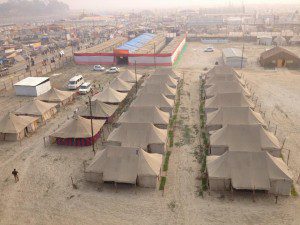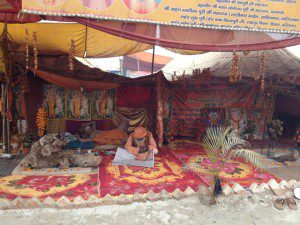The achievement is evidently impressive enough that Harvard University has sent an interdisciplinary team to “map the metabolism of the city,” according to Prof. Rahul Mehrotra, Professor and Chair of Urban Design and Planning. “While the Kumbh is often portrayed by Western media as a mythic spectacle of colorful humanity, Mehrotra and his team were more impressed with the everyday functioning of the mundane. In a country that can barely keep up with its exploding megacities — where electricity, clean water, and safety are rarely assured for hundreds of millions — how does a pop-up tent city manage to run so smoothly?”
Despite the display of devotion as well as organizational and logistical acumen on such a staggering scale, coverage of the mela in western media tends to be unflattering at best, with no mention of the excellent civic arrangements usually. Media also tends to be obsessed with portraying the “Naga Sadhus”, a marijuana-smoking Hindu sect of sadhus who are often naked, with matted hair and covered with a thick layer of ash, and who usually have the honor of taking the first ritual dip in the river on the holy bathing days.
Who are the naga sadhus? Why are they naked? Why are they known for violence? Why do they smoke marijuana if they are holy men? HAF is asked these questions more often than any others.
During Mughal rule, Muslim violence against sadhus was very high. However, sadhus could not retaliate due to their vow of ahimsa (or non-violence). Madhusudhana Saraswathi, then a Shankaracharya, approached King Akbar requesting him to help curb the violence. Akbar effectively ignored the request, and the creation of the Naga Sadhu tradition was the result. Naga Sadhus are trained to withstand any weather, have no worldly connections or institutional responsibilities, and have no need for clothes. They liberally smear themselves with ash to provide some insulation against the weather. They never initiate violence, but they will retaliate if other sadhus are attacked. That was the proposition that the Naga Sadhus created. That’s why they have the honor of bathing first at the Sangam in honor of their role as protectors of the other sadhus. Finally, as their role is not to impart spiritual instruction to others, knowledge transfer is not affected by their marijuana use.
Spiritually, they are followers of a great ancient saint named Dattatreya, and they seek to attain his status. Dattatreya was so merged with the universalconsciousness that he cared not in the least for his body, not even enough to wear clothes. The Naga sadhus is a corruption of the term Nanga (meaning naked) sadhus.




